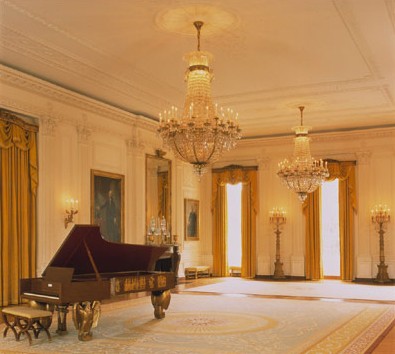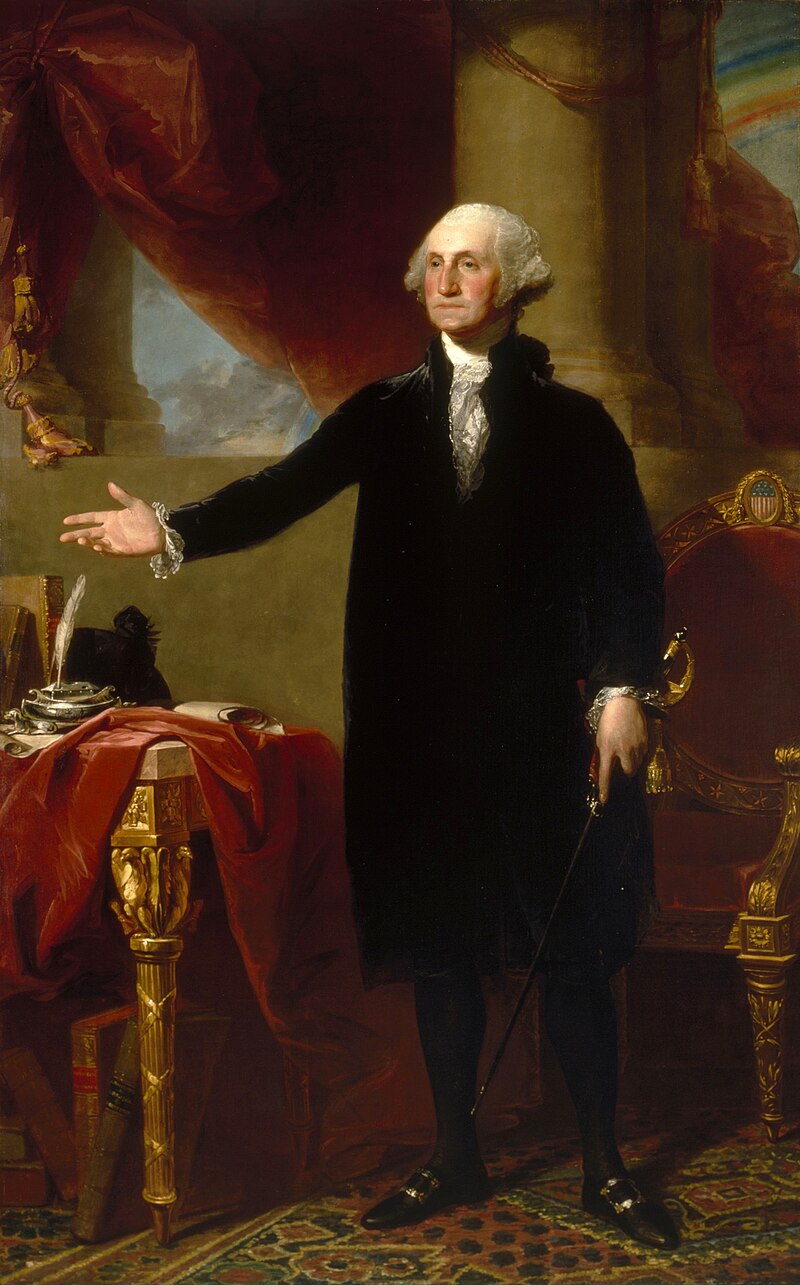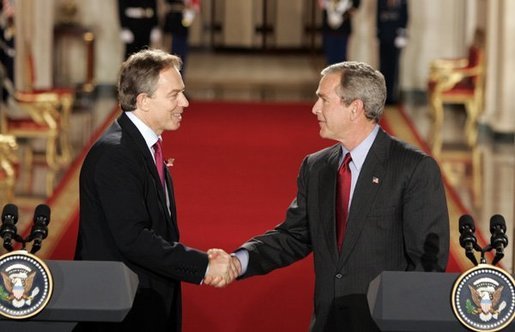The East Room is the largest room in the White House. Over the years it has served as the site of weddings, funerals, social events, the swearing-in of cabinet members and supreme court justices, receptions, press conferences, treaty signings, and even as a roller rink.
 |
| The East Room, Clinton Administration. Public Domain. |
When John and Abigail Adams, the first inhabitants of the White House, moved into the White House in 1800, the house was unfinished. The only item in the room was a copy of the Lansdowne portrait of George Washington painted by Gilbert Stuart in 1797. Abigail hung wet laundry in the otherwise-vacant room.
 |
| Gilbert Stuart, George Washington (Lansdowne portrait, 1796). Public Domain. |
The room was still incomplete when Thomas Jefferson became president. In 1803, architect and commissioner of public buildings Benjamin Henry Latrobe surveyed the White House, and he called the East Room a "public audience chamber" and noted the ceiling had "given way."
There was some concern that this room might look too much like a throne room, so Congress didn't appropriate funds to furnish it, although 38 gold and black chairs were ordered for the room during the Jefferson Administration.
Jefferson also had the room partitioned using sailcloth, to create a bedroom and office for Meriwether Lewis (of Lewis and Clark fame) and Lewis' secretary, Lewis Harvie.
 |
| Meriwether Lewis portrait by Charles Willson Peale, circa 1807. Public Domain. |
The next inhabitant of the White House, President Madison, held cabinet meetings in one of the partitioned areas. He requested that the barriers be made permanent, but after the White House was burned and gutted in 1814, the East Room was rebuilt as it had been originally conceived.
However, it still wasn't completed. Dances were held there from time to time, but for the most part between 1818 and 1829, it was used to store furniture. President John Quincy Adams was given money to complete the room, but he used it to repair other rooms.
At last, the East Room was finished during President Jackson's administration. The bare walls were papered in yellow; pale blue drapes were hung; a red-bordered blue and yellow rug was laid; the furniture was upholstered; three cut-glass chandeliers were purchased to light the large room; and plaster cornices were installed over the windows.
 |
| 1860 Reception of the Japanese Embassy. Public Domain. |
The East Room was redecorated several times, but it may have never needed it as it did during the early days of the Civil War. While awaiting the construction of more barracks to be built, 60 Kansas militiamen stayed in the East Room and did not treat it kindly, shooting bullets into the walls and damaging the carpet. Mary Todd Lincoln refurbished the reception room with velvet cloth wallpaper, lace curtains, damask drapes, and a $2500 carpet that was woven on the largest loom in the world. The refurbishments were not ready in time for the May, 1861 funeral for Colonel Elmer E. Ellsworth, the first Union Army soldier to die in the Civil War, which was held in the East Room.
By the time of Lincoln's death in 1865, however, the East Room already required a new refurbishment, as visitors to the White House who waited in the East Room often took souvenirs: they snipped pieces of drapes, took drapery cords or tassels, and ripped off pieces of the velvet wallpaper. It was in such a state when Abraham Lincoln lay in repose on a black catafalque in 1865, his body surrounded by mourners.
 |
| Lincoln Funeral in the East Room, 1865. Harper's Weekly. Public Domain |
A grand refurbishment was undertaken by the Grant Administration, just in time for daughter Nellie's 1874 wedding in the East Room. She was not the first bride to marry in the East Room, nor the last: seven weddings have been held in the East Room between 1832 - 1967.
 |
| The 1967 wedding of Lynda Byrd Johnson and Chuck Robb. Public Domain. |
 |
| President Harding's body lying in state in the East Room, 1923. https://goo.gl/images/x67Src |
 |
| John F. Kennedy's body is placed on a catafalque in the East Room in the early hours of November 23, 1963. Robert Knudsen, photographer. Public Domain. |
While it is a room of solemnity, it has also been a room of fun. Theodore Roosevelt's children enjoyed roller skating here. On another occasion, Roosevelt invited over fifty guests here to watch a wrestling match. Potato-sack races have been held here, as well as concerts and parties.
Roosevelt's Administration also oversaw the East Room's return to its earliest style: that of late 18th Century simplicity. The furnishings may have changed several times through the years, but it still retains this classical appearance.
 |
| President George W. Bush and UK Prime Minister Tony Blair, press conference in the East Room, 2004. Public Domain. |
One other thing remains the same: the East Room of the White House has been the scene of dozens of major events that have shaped America.
***
Susanne Dietze began writing love stories in high school, casting her friends in the starring roles. Today, she's the award-winning author of over a dozen historical romances who's seen her work on the ECPA, Amazon, and Publisher's Weekly Bestseller Lists for Inspirational Fiction. Married to a pastor and the mom of two, Susanne lives in California and enjoys fancy-schmancy tea parties, genealogy, the beach, and curling up on the couch with a costume drama and a plate of nachos. You can learn more about her at www.susannedietze.com.



I have really enjoyed reading your blog about each of these rooms. I like learning historical facts like this.
ReplyDeleteHi Linda! I'm so glad you've enjoyed the series. I've learned a lot too!
DeleteHave a wonderful day.
Thanks Susie. It is always fascinating to learn what you have researched. I love history!
ReplyDeleteI love history, too, Paula! There is always something new to learn.
DeleteThanks so much for coming by!
Susanne, thank you for sharing each blog post for the various White House rooms--wonderful history that is not taught.
ReplyDeleteHi Marilyn! It's amazing all that has happened in each of these rooms, plus so much more that we'll never know!
DeleteEnjoy the rest of your day!
So interesting! Thank you!
ReplyDeleteYou're most welcome, Connie! I appreciate you coming by and saying hi. Have a great day.
DeleteInteresting, Susie. I can't believe people were so disrespectful as to take souvenirs home. I mean, a ripped piece of fabric or wallpaper is nothing without the surroundings that gave it meaning.
ReplyDelete